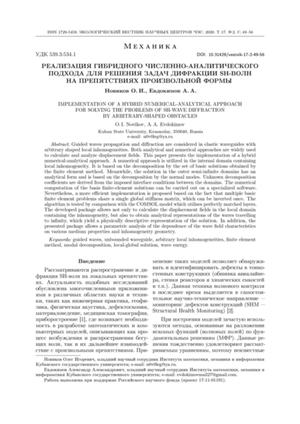Реализация гибридного численно-аналитического подхода для решения задач дифракции SH-волн на препятствиях произвольной формы
УДК
539.3:534.1DOI:
https://doi.org/10.31429/vestnik-17-2-49-56Аннотация
Рассматриваются антиплоские волны в упругих волноводах с локальной неоднородностью произвольной формы. Предлагается собственная реализация гибридного численно-аналитического подхода, основанная на получении численного конечно-элементного решения в области с локальной неоднородностью и аналитического решения во внешних полубесконечных областях. Аналитическое решение представлено в виде разложения по нормальным модам, коэффициенты которого определяются из условий стыковки на границе областей. Собственная реализация позволяет избежать дополнительных численных затрат, возникающих при использовании коммерческих конечно-элементных пакетов, за счёт возможности рассчитывать базисные конечно-элементные поля за одно обращение матрицы жесткости.Проведена верификация и демонстрация работы алгоритма на тестовой задаче.
Ключевые слова:
бегущие волны, протяжённый волновод, произвольные локальные неоднородности, метод конечных элементов, модальное разложение, локально-глобальное решение, волновая энергияИнформация о финансировании
Работа выполнена при поддержке Российского научного фонда (проект 17-11-01191).
Библиографические ссылки
- Боголюбов А.Н., Боголюбов Н.А., Свешников А.Г. Математическое моделирование волноведущих систем методом конечных разностей и конечных элементов // Физические основы приборостроения. 2013. Т. 2. № 1. С. 10–17. [Bogolyubov A.N., Bogolyubov N.A., Sveshnikov A.G. Matematicheskoye modelirovaniye volnovedushchikh sistem metodom konechnykh raznostey i konechnykh elementov [Mathematical modeling of waveguide systems by the method of finite differences and finite elements]. Fizicheskiye osnovy priborostroyeniya [Physical Foundations of Instrument Making], 2013, vol. 2, no. 1. pp. 10–17. DOI: 10.25210/jfop-1301-010017 (In Russian)]
- Giurgiutiu V. Structural Health Monitoring with Piezoelectric Wafer Active Sensors (2nd Edition). Elsevier Academic Press, 2014.
- Atluri S.N., Shen Sh. The meshless local Petrov–Galerkin (MLPG) method: a simple and less costly alternative to the finite element and boundary element methods // Comput Model. Eng. Sci. 2002. Vol. 3. № 1. P. 11–51.
- Бреббия К., Теллес Ж., Вроубел Л. Методы граничных элементов. М.: Мир, 1987. 524 с. [Brebbia C.A., Telles J.C.F., Wrobel L.C. Boundary Element Techniques: Theory and Applications in Engineering. Berlin etc.: Springer, 1984. DOI: 10.1007/978-3-642-48860-3]
- Глушков Е.В., Глушкова Н.В., Еремин А.А., Михаськив В.В. Метод слоистых элементов в динамической теории упругости // ПММ. 2009. Т. 73. Вып. 4. С. 622–634. [Glushkov E.V., Glushkova N.V., Eremin A.A., Mikhaskiv V.V. The layered element method in the dynamic theory of elasticity. J. Applied Mathematics and Mechanics, 2009, vol. 73, iss. 4, pp. 449–456. DOI: 10.1016/j.jappmathmech.2009.08.005]
- Shen Y., Giurgiutiu V. Effective non-reflective boundary for Lamb waves: Theory, finite element implementation, and applications // Wave Motion. 2015. Vol. 58. P. 22–41.
- Berenger J.-P.A perfectly matched layer for the absorption of electromagnetic waves // J. Computational Physics. 1994. Vol. 114(2). P. 185–200.
- Joly P. An elementary introduction to the construction and the analysis of perfectly matched layers for time domain wave propagation // SeMA J. 2012. Vol. 57. P. 5–48.
- Глушков Е.В., Глушкова Н.В., Евдокимов А.А. Гибридная численно-аналитическая схема для расчета дифракции упругих волн в локально неоднородных волноводах // Акустический журнал. 2018. Т. 64. № 1. С. 3–12. [Glushkov E.V., Glushkova N.V., Evdokimov A.A. Gibridnaya chislenno-analiticheskaya skhema dlya rascheta difraktsii uprugikh voln v lokal'no neodnorodnykh volnovodakh [Hybrid numerical-analytical scheme for calculating the diffraction of elastic waves in locally inhomogeneous waveguides]. Akusticheskiy zhurnal [Acoustic journal], 2018, vol. 64, no. 1, pp. 3–12. DOI: 10.7868/S0320791918010082]
- Glushkov E.V., Glushkova N.V., Golub M.V., Moll J., Fritzen C.-P. Wave energy trapping and localization in a plate with a delamination // Smart Materials and Structures J. 2012. Vol. 21. № 12.
- Glushkov E.V., Glushkova N.V., Eremin A.A., Lammering R. Trapped mode effects in notched plate-like structures // Sound and Vibration J. 2015. Vol. 358. P. 142–151.
Скачивания

Загрузки
Даты
Поступила в редакцию
Принята к публикации
Публикация
Как цитировать
Лицензия
Copyright (c) 2020 Новиков О.И., Евдокимов А.А.

Это произведение доступно по лицензии Creative Commons «Attribution» («Атрибуция») 4.0 Всемирная.


